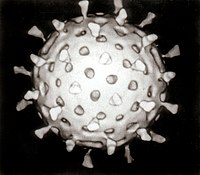
Photo from wikipedia
Anaplasmosis, a tick-borne illness caused by Anaplasma phagocytophilum (AP), presents with nonspecific clinical symptoms, including fever and headache, and is often accompanied by laboratory abnormalities of leukopenia, thrombocytopenia, and mildly… Click to show full abstract
Anaplasmosis, a tick-borne illness caused by Anaplasma phagocytophilum (AP), presents with nonspecific clinical symptoms, including fever and headache, and is often accompanied by laboratory abnormalities of leukopenia, thrombocytopenia, and mildly elevated liver function tests (LFTs). Laboratory confirmation of acute infection occurs with nucleic acid amplification testing (NAAT). ABSTRACT Anaplasmosis, a tick-borne illness caused by Anaplasma phagocytophilum (AP), presents with nonspecific clinical symptoms, including fever and headache, and is often accompanied by laboratory abnormalities of leukopenia, thrombocytopenia, and mildly elevated liver function tests (LFTs). Laboratory confirmation of acute infection occurs with nucleic acid amplification testing (NAAT). This retrospective cohort study aimed to develop a clinical decision support algorithm to aid in decision-making about test ordering. A data set was constructed with AP NAAT results and time-adjacent complete blood count and LFT results for adult patients tested for AP in a 12.5-year period. A second, smaller data set matched each patient with a positive AP NAAT to two patients with negative tests. Chart review for clinical symptoms was performed on this smaller data set. A decision tree algorithm was deployed to identify patient clusters with negative AP NAAT results. A total of 137/1,204 (11%) patients tested positive by NAAT for AP. In the larger, laboratory-only data set (n = 1,204), patients with a platelet count of >177 × 103/μl and age of <48 years had a negative AP NAAT (204/1,204, 17%, P < 0.05). In the smaller, cohorted data set with chart review (n = 402), patients with a platelet count of >188 × 103/μl and no fever or chills also did not have positive AP NAAT (58/402, 14%, P < 0.05). We generated two decision trees that can help determine the utility of AP NAAT using readily available clinical and laboratory data. These have the potential to significantly reduce unnecessary AP testing.
Journal Title: Journal of Clinical Microbiology
Year Published: 2021
Link to full text (if available)
Share on Social Media: Sign Up to like & get
recommendations!